Review of Energy Management Methods for Fuel Cell Vehicles: From the Perspective of Driving Cycle Information
Abstract
:1. Introduction
1.1. Motivations
1.2. Contributions
1.3. Organization
2. Driving Cycle Information Analysis
2.1. Driving Cycle Collection
2.2. Driving Cycle Processing
2.2.1. Driving Pattern Recognition
2.2.2. Driving Characteristic Prediction
3. Energy Management Methods for FCVs
3.1. Overview of Energy Management Methods for FCVs
3.2. Energy Management Methods for FCVs: Based on Driving Pattern Recognition
3.3. Energy Management Methods for FCVs: Based on Driving Characteristic Prediction
4. Conclusions and Prospects
- Accurate driving pattern recognition: The accuracy of driving pattern recognition is crucial for the development and implementation of EMMs. However, recognition accuracy and algorithm complexity are interrelated. Some advanced recognition algorithms in the existing literature have the problem of low recognition accuracy. In the future, the sampling time, the selection of characteristic parameters, and the recognition period can all be combined with advanced recognition algorithms to construct recognition methods with excellent recognition accuracy and efficiency.
- Short-term driving characteristic prediction: Affected by the impacts of real-world driving conditions, the driving characteristics of vehicles will change in real time. Therefore, short-term driving characteristic prediction remains a hot and challenging issue, as it depends on various factors like the prediction method and traffic conditions. In the future, with the help of V2V, V2X, ITS and predictive algorithms, driving characteristics like speed, mileage, slope, and traffic signal light states can be predicted in the short term.
- Real-time energy management optimization: Ideal energy management optimization methods can adaptively generate effective control decisions considering the DPR and DCP results. However, most current energy management optimization methods are difficult to apply to real vehicles. Advanced algorithms bring up more possibilities of real-time energy management optimization which are worth exploring. In the future, real-time/online/adaptive EMMs will be considered for supplying an excellent control effect.
- Integrated driving style recognition: Even the same driver can exhibit different driving styles under different road conditions, and different driving styles can directly affect the energy management of the FCVs. Therefore, introducing the influence of driving styles into the EMMs for FCVs will be valuable and crucial. However, driving style is often described qualitatively, and is not integrated into the EMMs. In the future, integrated driving style recognition of drivers in real social driving networks will improve the effectiveness of EMMs for FCVs.
Author Contributions
Funding
Institutional Review Board Statement
Informed Consent Statement
Data Availability Statement
Acknowledgments
Conflicts of Interest
Abbreviations
| NEV | New Energy Vehicle |
| BEV | Battery Electric Vehicle |
| PHEV | Plug-in Hybrid Electric Vehicle |
| FCV | Fuel Cell Vehicle |
| FC | Fuel Cell |
| ESS | Energy Storage System |
| EMM | Energy Management Method |
| NEDC | New European Driving Cycle |
| UDDS | Urban Dynamometer Driving Schedule |
| EUDC | Extra Urban Driving Cycle |
| WLTC | Worldwide harmonized Light-duty Test Cycle |
| WLTP | Worldwide harmonized Light-duty Test Procedure |
| CHTC | China Heavy-duty commercial vehicle Test Cycle |
| FE | Fuel Economy |
| SOC | State of Charge |
| OBD | On Board Diagnostics |
| GPS | Global Positioning System |
| V2V | Vehicle to Vehicle |
| V2X | Vehicle to Everything |
| ITS | Intelligent Transportation System |
| API | Application Programming Interface |
| PCA | Principal Component Analysis |
| KPCA | Kernel Principal Component Analysis |
| LDA-DE | Linear Discriminant Analysis with the Diagonal Eigenvalues |
| K-MPSO | K- Modified Particle Swarm Optimization |
| DPR | Driving Pattern Recognition |
| DCP | Driving Characteristic Prediction |
| SVM | Support Vector Machine |
| LVQ | Learning Vector Quantization |
| NN | Neural Network |
| ANN | Artificial Neural Network |
| GRNN | Generalized Regression Neural Network |
| BPNN | Back Propagation Neural Network |
| CNN | Convolutional Neural Network |
| LVQ-NN | Learning Vector Quantization Neural Network |
| LSTM | Long Short-Term Memory |
| LSTM-NN | Long Short-Term Memory-Neural Network |
| MC | Markov Chain |
| MTM | Markov Transition Matrix |
| TPM | Transition Probability Matrix |
| MCMC | Markov Chain combined with Monte Carlo |
| OL-MC | Online-Learning enhanced Markov Chain |
| CD-CS | Charge Depleting and Charge Sustaining |
| FLC | Fuzzy Logical Control |
| DP | Dynamic Programing |
| PMP | Pontryagin’s Minimum Principle |
| SDP | Stochastic Dynamic Programming |
| ADP | Adaptive Dynamic Programing |
| ECMS | Equivalent Consumption Minimization Strategy |
| MPC | Model Predictive Control |
| A-ECMS | Adaptive Equivalent Consumption Minimization Strategy |
| A-MPC | Adaptive Model Predictive Control |
| ANFIS-ECMS | Adaptive Neuro-Fuzzy Inference System-ECMS |
| RL | Reinforcement Learning |
| SL | Supervised Learning |
| AP-MPC | Speed Prediction Model Predictive Control |
| BDAC | Big Data-Assisted Communication |
| AI | Artificial Intelligence |
| IOV | Internet of Vehicles |
| TCRA | Traffic Condition Recognition Algorithm |
| GA | Genetic Algorithm |
| DQN-TPA | Deep Q-learning based Trip Pattern Adaptive |
| HIL | Hardware in Loop |
| KNN | K-Nearest Neighbor |
References
- Ma, Y.Y.; Wang, P.Y.; Li, B.; Li, J.H. Research on Energy Consumption Generation Method of Fuel Cell Vehicles: Based on Naturalistic Driving Data Mining. Machines 2022, 10, 1047. [Google Scholar] [CrossRef]
- Liu, T.; Tan, W.H.; Tang, X.L.; Zhang, J.W.; Xing, Y.; Cao, D.P. Driving conditions-driven energy management strategies for hybrid electric vehicles: A review. Renew. Sustain. Energy Rev. 2021, 151, 111521. [Google Scholar] [CrossRef]
- Hua, Y.F.; Dong, F. How can new energy vehicles become qualified relays from the perspective of carbon neutralization? Literature review and research prospect based on the Cite-Space knowledge map. Environ. Sci. Pollut. Res. 2022, 29, 55473–55491. [Google Scholar] [CrossRef] [PubMed]
- Habib, A.K.M.A.; Hasan, M.K.; Issa, G.F.; Singh, D.; Islam, S.; Ghazal, T.M. Lithium-Ion Battery Management System for Electric Vehicles: Constraints, Challenges, and Recommendations. Batteries 2023, 9, 152. [Google Scholar] [CrossRef]
- El Kattel, M.B.; Mayer, R.; Ely, F.; Cardoso, B.D. Comprehensive review of battery charger structures of EVs and HEVs for levels 1–3. Int. J. Circuit Theory Appl. 2023, 51, 3514–3542. [Google Scholar] [CrossRef]
- Salem, M.; Elnaggar, M.; Saad, M.S.; Fattah, H.A.A. Energy Management System for Fuel Cell-Battery Vehicles Using Multi objective Online Optimization. IEEE Access 2022, 10, 40629–40641. [Google Scholar] [CrossRef]
- Wang, P.Y.; Ma, Y.Y.; Li, J.H.; Gao, Y.K.; Zhang, Y.R.; Ma, D.H. A Novel Control Algorithm of the Air Supply Subsystem: Based on Dynamic Modeling of Proton Exchange Membrane Fuel Cell. Processes 2022, 10, 1499. [Google Scholar] [CrossRef]
- Bethoux, O. Hydrogen Fuel Cell Road Vehicles: State of the Art and Perspectives. Energies 2020, 13, 5843. [Google Scholar] [CrossRef]
- Aouzellag, H.; Amrouche, B.; Iffouzar, K.; Aouzellag, D. Proposed hysteresis energy management strategy based on storage system efficiency for hybrid electric vehicle. J. Energy Storage 2022, 54, 105259. [Google Scholar] [CrossRef]
- Hanschek, A.J.; Bouvier, Y.E.; Jesacher, E.; Grbovic, P.J. Analysis and Comparison of Power Distribution System Topologies for Low-Voltage DC-DC Automated Guided Vehicle Applications. Energies 2022, 15, 2012. [Google Scholar] [CrossRef]
- Rudolf, T.; Schurmann, T.; Schwab, S.; Hohmann, S. Toward Holistic Energy Management Strategies for Fuel Cell Hybrid Electric Vehicles in Heavy-Duty Applications. Proc. IEEE 2021, 109, 1094–1114. [Google Scholar] [CrossRef]
- Zhao, B.L.; Lv, C.; Hofman, T. Driving-Cycle-Aware Energy Management of Hybrid Electric Vehicles Using a Three-Dimensional Markov Chain Model. Automot. Innov. 2019, 2, 146–156. [Google Scholar] [CrossRef]
- Lin, X.Y.; Wu, J.Y.; Wei, Y.M. An ensemble learning velocity prediction-based energy management strategy for a plug-in hybrid electric vehicle considering driving pattern adaptive reference SOC. Energy 2021, 234, 121308. [Google Scholar] [CrossRef]
- Wang, P.Y.; Li, J.K.; Yu, Y.B.; Xiong, X.Y.; Zhao, S.J.; Shen, W.S. Energy management of plug-in hybrid electric vehicle based on trip characteristic prediction. J. Automob. Eng. 2020, 234, 2239–2259. [Google Scholar] [CrossRef]
- Ma, Y.Y.; Wang, P.Y.; Sun, T.J. Research on Energy Management Method of Plug-In Hybrid Electric Vehicle Based on Travel Characteristic Prediction. Energies 2021, 14, 6134. [Google Scholar] [CrossRef]
- Sun, R.J.; Tian, Y.X.; Zhang, H.B.; Yue, R.; Lv, B.; Chen, J.R. Data-Driven Synthetic Optimization Method for Driving Cycle Development. IEEE Access 2019, 7, 162559–162570. [Google Scholar] [CrossRef]
- Abidin, Z.A.I.B.Z.; Hushim, M.F.; Bin Ahmad, O. Batu Pahat Driving Cycle for Light Duty Gasoline Engine. In Proceedings of the International Research and Innovation Summit (IRIS 2017), Melaka, Malaysia, 6–7 May 2017. [Google Scholar]
- Kayma, H.; Korkmaz, H.; Erdal, H. Development of a driving cycle for Istanbul bus rapid transit based on real-world data using stratified sampling method. Transp. Res. Part D Transp. Environ. 2019, 75, 123–135. [Google Scholar] [CrossRef]
- Silva, I.; Naranjo, J.E. A Systematic Methodology to Evaluate Prediction Models for Driving Style Classification. Sensors 2020, 20, 1692. [Google Scholar] [CrossRef]
- Feroldi, D.; Carignano, M. Sizing for fuel cell/supercapacitor hybrid vehicles based on stochastic driving cycles. Appl. Energy 2016, 183, 645–658. [Google Scholar] [CrossRef]
- Kasimalla, V.K.; Srinivasulu, G.N.; Velisala, V. A review on energy allocation of fuel cell/battery/ultracapacitor for hybrid electric vehicles. Int. J. Energy Res. 2018, 42, 4263–4283. [Google Scholar] [CrossRef]
- Sorlei, I.-S.; Bizon, N.; Thounthong, P.; Varlam, M.; Carcadea, E.; Culcer, M.; Iliescu, M.; Raceanu, M. Fuel Cell Electric Vehicles—A Brief Review of Current Topologies and Energy Management Strategies. Energies 2021, 14, 252. [Google Scholar] [CrossRef]
- Zhang, H.B.; Li, Q.; Wang, H.Q.; Li, Q.Y.; Qin, G.F.; Wu, Q. A review of energy management optimization based on the equivalent consumption minimization strategy for fuel cell hybrid power systems. Fuel Cells 2022, 22, 116–130. [Google Scholar] [CrossRef]
- Rasool, M.; Khan, M.A.; Zou, R.M. A Comprehensive Analysis of Online and Offline Energy Management Approaches for Optimal Performance of Fuel Cell Hybrid Electric Vehicles. Energies 2023, 16, 3325. [Google Scholar] [CrossRef]
- Mohammed, A.S.; Atnaw, S.M.; Salau, A.O.; Eneh, J.N. Review of optimal sizing and power management strategies for fuel cell/battery/super capacitor hybrid electric vehicles. Energy Rep. 2023, 9, 2213–2228. [Google Scholar] [CrossRef]
- Wang, Y.; Li, K.Q.; Zeng, X.H.; Gao, B.L.; Hong, J.C. Energy consumption characteristics based driving conditions construction and prediction for hybrid electric buses energy management. Energy 2022, 245, 123189. [Google Scholar] [CrossRef]
- Kommuri, N.K.; McGordon, A.; Allen, A.; Truong, D.Q. A Novel Adaptive Equivalence Fuel Consumption Minimisation Strategy for a Hybrid Electric Two-Wheeler. Energies 2022, 15, 3192. [Google Scholar] [CrossRef]
- Wang, Y.F.; Zhang, N.; Wu, Y.; Liu, B.J.; Wu, Y. A strategy of electrical energy management for internal combustion engine vehicle based on driving cycle recognition and electrical load perception. Adv. Mech. Eng. 2018, 10, 1687814018809236. [Google Scholar] [CrossRef]
- Zhang, Q.; Fu, X.L. A Neural Network Fuzzy Energy Management Strategy for Hybrid Electric Vehicles Based on Driving Cycle Recognition. Appl. Sci. 2020, 10, 696. [Google Scholar] [CrossRef]
- Shi, D.P.; Li, S.P.; Liu, K.J.; Wang, Y.; Liu, R.J.; Guo, J.J. Adaptive Energy Management Strategy Based on Intelligent Prediction of Driving Cycle for Plug-In Hybrid Electric Vehicle. Processes 2022, 10, 1831. [Google Scholar] [CrossRef]
- Humphreys, T.E.; Murrian, M.J.; Narula, L. Deep-Urban Unaided Precise Global Navigation Satellite System Vehicle Positioning. IEEE Intell. Transp. Syst. Mag. 2020, 12, 109–122. [Google Scholar] [CrossRef]
- Abdelrahman, A.E.; Hassanein, H.S.; Abu-Ali, N. Robust Data-Driven Framework for Driver Behavior Profiling Using Supervised Machine Learning. IEEE Trans. Intell. Transp. Syst. 2022, 23, 3336–3350. [Google Scholar] [CrossRef]
- Yao, Y.; Zhao, X.H.; Wu, Y.P.; Zhang, Y.L.; Rong, J. Clustering driver behavior using dynamic time warping and hidden Markov model. J. Intell. Transp. Syst. 2021, 25, 249–262. [Google Scholar] [CrossRef]
- Tong, H.Y.; Ng, K. Development of bus driving cycles using a cost effective data collection approach. Sustain. Cities Soc. 2021, 69, 102854. [Google Scholar] [CrossRef]
- Gao, K.; Huang, S.; Xie, J.; Xiong, N.N.; Du, R.H. A Review of Research on Intersection Control Based on Connected Vehicles and Data-Driven Intelligent Approaches. Electronics 2020, 9, 885. [Google Scholar] [CrossRef]
- Han, B.; Wu, Z.H.; Gu, C.Y.; Ji, K.; Xu, J.G. Developing a Regional Drive Cycle Using GPS-Based Trajectory Data from Rideshare Passenger Cars: A Case of Chengdu, China. Sustainability 2021, 13, 2114. [Google Scholar] [CrossRef]
- Tu, R.; Xu, J.S.; Wang, A.; Zhang, M.Q.; Zhai, Z.Q.; Hatzopoulou, M. Real-world emissions and fuel consumption of gasoline and hybrid light duty vehicles under local and regulatory drive cycles. Sci. Total Environ. 2022, 805, 150407. [Google Scholar] [CrossRef]
- Hong, S.; Cui, S.M.; Hwang, H.; Joe, I.; Kim, W.T. Personalized Energy Consumption Prediction of CAEVs With Personal Driving Cycle Selection. IEEE Access 2022, 10, 54459–54473. [Google Scholar] [CrossRef]
- Bhatti, A.H.U.; Kazmi, S.A.A.; Tariq, A.; Ali, G. Development and analysis of electric vehicle driving cycle for hilly urban areas. Transp. Res. Part D Transp. Environ. 2021, 99, 103025. [Google Scholar] [CrossRef]
- Rechkemmer, S.K.; Zang, X.Y.; Boronka, A.; Zhang, W.M.; Sawodny, O. Utilization of Smartphone Data for Driving Cycle Synthesis Based on Electric Two-Wheelers in Shanghai. IEEE Trans. Intell. Transp. Syst. 2021, 22, 876–886. [Google Scholar] [CrossRef]
- Peng, J.K.; Jiang, J.W.; Ding, F.; Tan, H.C. Development of Driving Cycle Construction for Hybrid Electric Bus: A Case Study in Zhengzhou, China. Sustainability 2020, 12, 7188. [Google Scholar] [CrossRef]
- Lee, T.K.; Kuo, Y.C.; Huang, S.H.; Wang, G.S.; Lin, C.Y.; Tseng, Y.C. Augmenting Car Surrounding Information by Inter-Vehicle Data Fusion. In Proceedings of the IEEE Wireless Communications and Networking Conference (WCNC), Marrakesh, Morocco, 15–18 April 2019. [Google Scholar]
- Zhao, X.; Zhao, X.M.; Yu, Q.; Ye, Y.M.; Yu, M. Development of a representative urban driving cycle construction methodology for electric vehicles: A case study in Xi’an. Transp. Res. Part D Transp. Environ. 2020, 81, 102279. [Google Scholar] [CrossRef]
- Zhao, M.R.; Gao, H.N.; Han, Q.; Ge, J.A.; Wang, W.; Qu, J. Development of a Driving Cycle for Fuzhou Using K-Means and AMPSO. J. Adv. Transport. 2021, 2021, 5430137. [Google Scholar] [CrossRef]
- Peng, Y.H.; Zhuang, Y.; Yang, H.B. Development of a representative driving cycle for urban buses based on the K-means cluster method. Clust. Comput. 2019, 22, S6871–S6880. [Google Scholar]
- Zhang, J.; Wang, Z.P.; Liu, P.; Zhang, Z.S.; Li, X.Y.; Qu, C.H. Driving cycles construction for electric vehicles considering road environment: A case study in Beijing. Appl. Energy 2019, 253, 113514. [Google Scholar] [CrossRef]
- Jing, Z.C.; Wang, T.X.; Zhang, S.P.; Wang, G.L. Development Method for the Driving Cycle of Electric Vehicles. Energies 2022, 15, 8715. [Google Scholar] [CrossRef]
- Liu, C.N.; Liu, Y. Energy Management Strategy for Plug-In Hybrid Electric Vehicles Based on Driving Condition Recognition: A Review. Electronics 2022, 11, 342. [Google Scholar] [CrossRef]
- Shi, Q.; Liu, B.J.; Guan, Q.S.; He, L.; Qiu, D.Y. A genetic ant colony algorithm-based driving cycle generation approach for testing driving range of battery electric vehicle. Adv. Mech. Eng. 2020, 12, 1687814019901054. [Google Scholar] [CrossRef]
- Wang, L.; Ma, J.; Zhao, X.; Li, X.B. Development of a Typical Urban Driving Cycle for Battery Electric Vehicles Based on Kernel Principal Component Analysis and Random Forest. IEEE Access 2021, 9, 15053–15065. [Google Scholar] [CrossRef]
- Guo, S.Q.; Wu, K.K.; Zhang, G.Q. Application of PCA-K-means++ combination model to construction of light vehicle driving conditions in intelligent traffic. J. Meas. Eng. 2020, 8, 107–121. [Google Scholar] [CrossRef]
- Chandrasekar, K.S.; Geetha, P. A new formation of supervised dimensionality reduction method for moving vehicle classification. Neural Comput. Appl. 2021, 33, 7839–7850. [Google Scholar] [CrossRef]
- Chandrashekar, C.; Agrawal, P.; Chatterjee, P.; Pawar, D.S. Development of E-rickshaw driving cycle (ERDC) based on micro-trip segments using random selection and K-means clustering techniques. IATSS Res. 2021, 45, 551–560. [Google Scholar] [CrossRef]
- Qiu, H.X.; Cui, S.Z.; Wang, S.T.; Wang, Y.Z.; Feng, M.L. A Clustering-Based Optimization Method for the Driving Cycle Construction: A Case Study in Fuzhou and Putian, China. IEEE Trans. Intell. Transp. Syst. 2022, 23, 18681–18694. [Google Scholar] [CrossRef]
- Yan, W.; Li, M.J.; Zhong, Y.C.; Qu, C.Y.; Li, G.X. A Novel k-MPSO Clustering Algorithm for the Construction of Typical Driving Cycles. IEEE Access 2020, 8, 64028–64036. [Google Scholar] [CrossRef]
- Lei, Z.Z.; Cheng, D.; Liu, Y.G.; Qin, D.T.; Zhang, Y.; Xie, Q.B. A Dynamic Control Strategy for Hybrid Electric Vehicles Based on Parameter Optimization for Multiple Driving Cycles and Driving Pattern Recognition. Energies 2017, 10, 54. [Google Scholar] [CrossRef]
- Shi, Y.M.; Cui, N.X.; Du, Y. Energy Management Strategy based on Driving Style Recognition for Plug-in Hybrid Electric Bus. In Proceedings of the 39th Chinese Control Conference (CCC), Shenyang, China, 27–29 July 2020. [Google Scholar]
- Liu, B.J.; Shi, Q.; He, Z.J.; Wei, Y.J.; Qiu, D.Y.; He, L. A driving-cycle predictive control approach for energy consumption optimization of hybrid electric vehicle. Proc. Inst. Mech. Eng. Part D J. Automob. Eng. 2022, 236, 2507–2518. [Google Scholar] [CrossRef]
- Zhang, N.N.; Cao, C.C.; Yu, H.F. The Cycle Recognition Algorithm Based on Daubechies wavelet and fuzzy C-means clustering. In Proceedings of the 35th Chinese Control Conference (CCC), Chengdu, China, 27–29 July 2016. [Google Scholar]
- Mao, L.; Fotouhi, A.; Shateri, N.; Ewin, N. A multi-mode electric vehicle range estimator based on driving pattern recognition. Proc. Inst. Mech. Eng. Part C J. Mech. Eng. Sci. 2021, 236, 2677–2697. [Google Scholar] [CrossRef]
- Montazeri-Gh, M.; Mahmoodi-K, M. Optimized predictive energy management of plug-in hybrid electric vehicle based on traffic condition. J. Clean. Prod. 2016, 139, 935–948. [Google Scholar] [CrossRef]
- Liu, Z.D.; Jia, H.F.; Wang, Y.X. Urban expressway parallel pattern recognition based on intelligent IOT data processing for smart city. Comput. Commun. 2020, 155, 40–47. [Google Scholar] [CrossRef]
- Matignon, M.; Azib, T.; Mcharek, M.; Chaibet, A.; Ceschia, A. Real-Time Integrated Energy Management Strategy Applied to Fuel Cell Hybrid Systems. Energies 2023, 16, 2645. [Google Scholar] [CrossRef]
- Xu, B.; Shi, J.Z.; Li, S.X.; Li, H.Y. A Study of Vehicle Driving Condition Recognition Using Supervised Learning Methods. IEEE Trans. Transp. Electrif. 2022, 8, 1665–1673. [Google Scholar] [CrossRef]
- Zhang, X.; Wu, G.; Dong, Z.M.; Crawford, C. Embedded feature-selection support vector machine for driving pattern recognition. J. Frankl. Inst. 2015, 352, 669–685. [Google Scholar] [CrossRef]
- Han, Q.; Zhao, X.; Ma, J.; Wang, S.; Zhang, K.; Chai, H.; Yang, Y.Z.; Zheng, Z.C. Transfer Deep Reinforcement Learning-Based Energy Management Strategy for Plug-In Hybrid Electric Heavy-Duty Trucks under Segmented Usage Scenarios. Int. J. Energy Res. 2023, 2023, 1875380. [Google Scholar] [CrossRef]
- Liang, K.C.; Zhao, Z.G.; Li, W.C.; Zhou, J.W.; Yan, D.S. Comprehensive Identification of Driving Style Based on Vehicle’s Driving Cycle Recognition. IEEE Trans. Veh. Technol. 2023, 72, 312–326. [Google Scholar] [CrossRef]
- Chen, D.D.; Wang, T.; Qiao, T.Y.; Yang, T.T.; Ji, Z.Y. Driving Cycle Recognition Based Adaptive Equivalent Consumption Minimization Strategy for Hybrid Electric Vehicles. IEEE Access 2022, 10, 77732–77743. [Google Scholar] [CrossRef]
- Hu, J.J.; Niu, X.Y.; Jiang, X.Y.; Zu, G.Q. Energy management strategy based on driving pattern recognition for a dual-motor battery electric vehicle. Int. J. Energy Res. 2019, 43, 3346–3364. [Google Scholar] [CrossRef]
- Zhou, Y.; Ravey, A.; Pera, M.C. A survey on driving prediction techniques for predictive energy management of plug-in hybrid electric vehicles. J. Power Sources 2019, 412, 480–495. [Google Scholar] [CrossRef]
- Chen, Z.; Yang, C.; Fang, S.N. A Convolutional Neural Network-Based Driving Cycle Prediction Method for Plug-in Hybrid Electric Vehicles with Bus Route. IEEE Access 2020, 8, 3255–3564. [Google Scholar] [CrossRef]
- Liu, C.; Chen, Y.; Zhao, L. An adaptive prediction method based on data stream mining for future driving cycle of vehicle. Proc. Inst. Mech. Eng. Part D J. Automob. Eng. 2021, 235, 1702–1712. [Google Scholar] [CrossRef]
- Li, L.; Sun, H.C.; Tao, F.Z.; Fu, Z.M. Driving cycle prediction based on Markov chain combined with driving information mining. Proc. Inst. Mech. Eng. Part D J. Automob. Eng. 2023, 09544070231171741. [Google Scholar] [CrossRef]
- Xie, H.; Hu, D.; Song, K. An Iterative Optimization Algorithm for Vehicle Speed Prediction Considering Driving Style and Historical Data Effects. In Proceedings of the 40th Chinese Control Conference (CCC), Shanghai, China, 26–28 July 2021. [Google Scholar]
- Hwang, G.; Hwang, Y.; Shin, S.; Park, J.; Lee, S.; Kim, M. Comparative Study on the Prediction of City Bus Speed Between LSTM and GRU. Int. J. Automot. Technol. 2022, 23, 983–992. [Google Scholar] [CrossRef]
- Lin, X.Y.; Zhang, G.J.; Wei, S.S. Velocity prediction using Markov Chain combined with driving pattern recognition and applied to Dual-Motor Electric Vehicle energy consumption evaluation. Appl. Soft Comput. 2021, 101, 106998. [Google Scholar] [CrossRef]
- Xing, J.M.; Chu, L.; Hou, Z.R.; Sun, W.; Zhang, Y.J. Energy Management Strategy Based on a Novel Speed Prediction Method. Sensors 2021, 21, 8273. [Google Scholar] [CrossRef]
- Zhang, L.P.; Liu, W.; Qi, B.N. Energy optimization of multi-mode coupling drive plug-in hybrid electric vehicles based on speed prediction. Energy 2020, 206, 118126. [Google Scholar] [CrossRef]
- Zhang, L.P.; Liu, W.; Qi, B.N. Combined Prediction for Vehicle Speed with Fixed Route. Chin. J. Mech. Eng. 2020, 33, 60. [Google Scholar] [CrossRef]
- Shin, J.; Yeon, K.; Kim, S.; Sunwoo, M.; Han, M. Comparative Study of Markov Chain With Recurrent Neural Network for Short Term Velocity Prediction Implemented on an Embedded System. IEEE Access 2021, 9, 24755–24767. [Google Scholar] [CrossRef]
- Li, X.C.; Lin, W.P.; Jin, Y.Y.; Chen, D.X.; Chen, T. Dynamic Energy Management Strategy of Hybrid Electric Vehicles based on Velocity Prediction. In Proceedings of the 6th IFAC Conference on Engine Powertrain Control, Simulation and Modeling (E-COSM), Tokyo, Japan, 23–25 August 2021. [Google Scholar]
- Hu, Q.H.; Amini, M.R.; Wiese, A.; Seeds, J.B.; Kolmanovsky, I.; Sun, J. A Multirange Vehicle Speed Prediction With Application to Model Predictive Control-Based Integrated Power and Thermal Management of Connected Hybrid Electric Vehicles. J. Dyn. Syst. Meas. Control. 2022, 144, 011105. [Google Scholar] [CrossRef]
- Arnau, F.J.; Pla, B.; Bares, P.; Perin, A.T. Eco-Driving Optimization of a Signalized Route With Extended Traffic State Information. IEEE Intell. Transp. Syst. Mag. 2023, 15, 35–45. [Google Scholar] [CrossRef]
- Adelberger, D.; Deng, J.P.; del Re, L. V2X Database Driven Traffic Speed Prediction. In Proceedings of the 2021 IEEE Intelligent Transportation Systems Conference (ITSC), Indianapolis, IN, USA, 19–22 September 2021. [Google Scholar]
- Hyeon, E.; Kim, Y.; Prakash, N.; Stefanopoulou, A.G. Short-term Speed Forecasting Using Vehicle Wireless Communications. In Proceedings of the 2019 American Control Conference (ACC), Philadelphia, PA, USA, 10–12 July 2019. [Google Scholar]
- An, C.; Wu, C. Traffic big data assisted V2X communications toward smart transportation. Wirel. Netw. 2020, 26, 1601–1610. [Google Scholar] [CrossRef]
- Jiang, B.N.; Fei, Y.S. Vehicle Speed Prediction by Two-Level Data Driven Models in Vehicular Networks. IEEE Trans. Intell. Transp. Syst. 2017, 18, 1793–1801. [Google Scholar] [CrossRef]
- Miao, Y.J.; Wei, L.Y. Urban Road Network Traffic Volume Prediction Based on Road Section Speed. In Proceedings of the 2018 Prognostics and System Health Management Conference, Chongqing, China, 26–28 October 2018. [Google Scholar]
- Wang, S.Q.; Wang, Z.Z. Intelligent Driving Strategy of Expressway Based on Big Data of Road Network and Driving Time. IEEE Access 2023, 11, 44854–44865. [Google Scholar] [CrossRef]
- Overview of Gaode Web Services API. Available online: https://lbs.amap.com/api/webservice/summary/ (accessed on 10 August 2023).
- Yue, M.L.; Al Masry, Z.; Jemei, S.; Zerhouni, N. An online prognostics-based health management strategy for fuel cell hybrid electric vehicles. Int. J. Hydrogen Energy 2021, 46, 13206–13218. [Google Scholar] [CrossRef]
- Deng, K.; Liu, Y.X.; Hai, D.; Peng, H.J.; Lowenstein, L.; Pischinger, S.; Hameyer, K. Deep reinforcement learning based energy management strategy of fuel cell hybrid railway vehicles considering fuel cell aging. Energy Convers. Manag. 2022, 251, 115030. [Google Scholar] [CrossRef]
- Ferrara, A.; Jakubek, S.; Hametner, C. Energy management of heavy-duty fuel cell vehicles in real-world driving scenarios: Robust design of strategies to maximize the hydrogen economy and system lifetime. Energy Convers. Manag. 2021, 232, 113795. [Google Scholar] [CrossRef]
- Gim, J.; Kim, M.; Ahn, C. Energy Management Control Strategy for Saving Trip Costs of Fuel Cell/Battery Electric Vehicles. Energies 2022, 15, 2131. [Google Scholar] [CrossRef]
- Ferrara, A.; Hametner, C. Impact of Energy Management Strategies on Hydrogen Consumption and Start-Up/Shut-Down Cycles in Fuel Cell-Ultracapacitor-Battery Vehicles. IEEE Trans. Veh. Technol. 2022, 71, 5692–5703. [Google Scholar] [CrossRef]
- Perez-Davila, O.; Fernandez, R.A. Optimization algorithm applied to extended range fuel cell hybrid vehicles. Contribution to road transport decarbonization. Energy 2023, 267, 126519. [Google Scholar] [CrossRef]
- Xu, N.; Kong, Y.; Chu, L.; Ju, H.; Yang, Z.; Xu, Z.; Xu, Z.Q. Towards a Smarter Energy Management System for Hybrid Vehicles: A Comprehensive Review of Control Strategies. Appl. Sci. 2019, 9, 2026. [Google Scholar] [CrossRef]
- Zhang, G.R.; Chen, W.R.; Li, Q. Modeling, optimization and control of a FC/battery hybrid locomotive based on ADVISOR. Int. J. Hydrogen Energy 2017, 42, 18568–18583. [Google Scholar] [CrossRef]
- Wu, X.H.; Hu, X.S.; Yin, X.F.; Li, L.; Zeng, Z.W.; Pickert, V. Convex programming energy management and components sizing of a plug-in fuel cell urban logistics vehicle. J. Power Sources 2019, 423, 358–366. [Google Scholar] [CrossRef]
- Zhang, Y.; Chen, M.; Cai, S.; Hou, S.Y.; Yin, H.; Gao, J.W. An online energy management strategy for fuel cell hybrid vehicles. In Proceedings of the 40th Chinese Control Conference (CCC), Shanghai, China, 26–28 July 2021. [Google Scholar]
- Schmid, R.; Buerger, J.; Bajcinca, N. Energy management for series-production plug-in-hybrid electric vehicles based on predictive DP-PMP. At-Autom. 2021, 69, 52–64. [Google Scholar] [CrossRef]
- Fletcher, T.; Thring, R.; Watkinson, M. An Energy Management Strategy to concurrently optimise fuel consumption & PEM fuel cell lifetime in a hybrid vehicle. Int. J. Hydrogen Energy 2016, 41, 21503–21515. [Google Scholar]
- Peng, H.J.; Li, J.X.; Thul, A.; Deng, K.; Unlubayir, C.; Lowenstein, L.; Hameyer, K. A scalable, causal, adaptive rule-based energy management for fuel cell hybrid railway vehicles learned from results of dynamic programming. Etransportation 2020, 4, 100057. [Google Scholar] [CrossRef]
- Farhadi Gharibeh, H.; Farrokhifar, M. Online Multi-Level Energy Management Strategy Based on Rule-Based and Optimization-Based Approaches for Fuel Cell Hybrid Electric Vehicles. Appl. Sci. 2021, 11, 3849. [Google Scholar] [CrossRef]
- Li, H.; Ravey, A.; N’Diaye, A.; Djerdir, A. Online adaptive equivalent consumption minimization strategy for fuel cell hybrid electric vehicle considering power sources degradation. Energy Convers. Manag. 2019, 192, 133–149. [Google Scholar] [CrossRef]
- Li, Q.Y.; Yang, H.Z. Evaluation of two model predictive control schemes with different error compensation strategies for power management in fuel cell hybrid electric buses. J. Energy Storage 2023, 72, 108148. [Google Scholar] [CrossRef]
- Han, J.; Park, Y.; Kum, D. Optimal adaptation of equivalent factor of equivalent consumption minimization strategy for fuel cell hybrid electric vehicles under active state inequality constraints. J. Power Sources 2014, 267, 491–502. [Google Scholar] [CrossRef]
- Hu, X.; Liu, S.K.; Song, K.; Gao, Y.; Zhang, T. Novel Fuzzy Control Energy Management Strategy for Fuel Cell Hybrid Electric Vehicles Considering State of Health. Energies 2021, 14, 6481. [Google Scholar] [CrossRef]
- Mounica, V.; Obulesu, Y.P. Hybrid Power Management Strategy with Fuel Cell, Battery, and Supercapacitor for Fuel Economy in Hybrid Electric Vehicle Application. Energies 2022, 15, 4185. [Google Scholar] [CrossRef]
- Fu, J.; Zeng, L.H.; Lei, J.Z.; Deng, Z.H.; Fu, X.W.; Li, X.; Wang, Y. A Real-Time Load Prediction Control for Fuel Cell Hybrid Vehicle. Energies 2022, 15, 3700. [Google Scholar] [CrossRef]
- Sun, H.C.; Tao, F.Z.; Fu, Z.M.; Gao, A.Y.; Jiao, L.Y. Driving-Behavior-Aware Optimal Energy Management Strategy for Multi-Source Fuel Cell Hybrid Electric Vehicles Based on Adaptive Soft Deep-Reinforcement Learning. IEEE Trans. Intell. Transp. Syst. 2023, 24, 4127–4146. [Google Scholar] [CrossRef]
- Ganesh, A.H.; Xu, B. A review of reinforcement learning based energy management systems for electrified powertrains: Progress, challenge, and potential solution. Renew. Sustain. Energy Rev. 2021, 154, 111833. [Google Scholar] [CrossRef]
- Venkatasatish, R.; Dhanamjayulu, C. Reinforcement learning based energy management systems and hydrogen refuelling stations for fuel cell electric vehicles: An overview. Int. J. Hydrogen Energy 2022, 47, 27646–27670. [Google Scholar] [CrossRef]
- Fayyazi, M.; Sardar, P.; Thomas, S.I.; Daghigh, R.; Jamali, A.; Esch, T.; Kemper, H.; Langari, R.; Khayyam, H. Artificial Intelligence/Machine Learning in Energy Management Systems, Control, and Optimization of Hydrogen Fuel Cell Vehicles. Sustainability 2023, 15, 5249. [Google Scholar] [CrossRef]
- Dayeni, M.K.; Soleymani, M. Intelligent energy management of a fuel cell vehicle based on traffic condition recognition. Clean Technol. Environ. Policy 2016, 18, 1945–1960. [Google Scholar] [CrossRef]
- Zhang, R.; Tao, J.L.; Zhou, H.Y. Fuzzy Optimal Energy Management for Fuel Cell and Supercapacitor Systems Using Neural Network Based Driving Pattern Recognition. IEEE Trans. Fuzzy Syst. 2018, 27, 45–57. [Google Scholar] [CrossRef]
- Song, K.; Li, F.Q.; Hu, X.; He, L.; Niu, W.X.; Lu, S.H.; Zhang, T. Multi-mode energy management strategy for fuel cell electric vehicles based on driving pattern identification using learning vector quantization neural network algorithm. J. Power Sources 2018, 389, 230–239. [Google Scholar] [CrossRef]
- Zhang, Q.; Han, J.Q.; Li, G.; Liu, Y. An Adaptive Energy Management Strategy for Fuel Cell/Battery/Supercapacitor Hybrid Energy Storage Systems of Electric Vehicles. Int. J. Electrochem. Sci. 2020, 15, 3410–3433. [Google Scholar] [CrossRef]
- Zhou, Y.; Ravey, A.; Pera, M.C. Multi-mode predictive energy management for fuel cell hybrid electric vehicles using Markov driving pattern recognizer. Appl. Energy 2020, 258, 114057. [Google Scholar] [CrossRef]
- Hu, J.J.; Wang, Y.G.; Zou, L.B.; Wang, Z.X. Adaptive rule control strategy for composite energy storage fuel cell vehicle based on vehicle operating state recognition. Renew. Energy 2023, 204, 166–175. [Google Scholar] [CrossRef]
- Wang, Y.C.; Zhang, Y.Z.; Zhang, C.Z.; Zhou, J.M.; Hu, D.H.; Yi, F.Y.; Fan, Z.X.; Zeng, T. Genetic algorithm-based fuzzy optimization of energy management strategy for fuel cell vehicles considering driving cycles recognition. Energy 2023, 263, 126112. [Google Scholar] [CrossRef]
- Li, M.C.; Wang, Y.J.; Yu, P.L.; Sun, Z.D.; Chen, Z.H. Online adaptive energy management strategy for fuel cell hybrid vehicles based on improved cluster and regression learner. Energy Convers. Manag. 2023, 292, 117388. [Google Scholar] [CrossRef]
- Lin, X.Y.; Xu, X.H.; Wang, Z.R. Deep Q-learning network based trip pattern adaptive battery longevity-conscious strategy of plug-in fuel cell hybrid electric vehicle. Appl. Energy 2022, 321, 119378. [Google Scholar] [CrossRef]
- Opila, D.F. Uncertain Route, Destination, and Traffic Predictions in Energy Management for Hybrid, Plug-in, and Fuel-Cell Vehicles. In Proceedings of the 2016 American Control Conference (ACC), Boston, MA, USA, 6–8 July 2016. [Google Scholar]
- Rehlaender, P.; Kemper, P.; Schwung, A.; Witkowski, U. A Novel Predictive Energy Management System. In Proceedings of the 11th UKSim-AMSS European Modelling Symposium on Computer Modelling and Simulation (EMS), Manchester, UK, 20–22 November 2017. [Google Scholar]
- Yuan, J.N.; Yang, L.; Chen, Q. Intelligent energy management strategy based on hierarchical approximate global optimization for plug-in fuel cell hybrid electric vehicles. Int. J. Hydrogen Energy 2018, 43, 8063–8078. [Google Scholar] [CrossRef]
- Zhou, Y.; Ravey, A.; Pera, M.C. Real-time Predictive Energy Management for Fuel Cell Electric Vehicles. In Proceedings of the 2021 IEEE Transportation Electrification Conference and Expo (ITEC), Electronic Network, 21–25 June 2021. [Google Scholar]
- Liu, Y.G.; Li, J.; Chen, Z.; Qin, D.T.; Zhang, Y. Research on a multi-objective hierarchical prediction energy management strategy for range extended fuel cell vehicles. J. Power Sources 2019, 429, 55–66. [Google Scholar] [CrossRef]
- Zhou, Y.; Li, H.; Ravey, A.; Pera, M.C. An integrated predictive energy management for light-duty range-extended plug-in fuel cell electric vehicle. J. Power Sources 2020, 451, 227780. [Google Scholar] [CrossRef]
- Zhou, Y.; Ravey, A.; Pera, M.C. Multi-objective energy management for fuel cell electric vehicles using online-learning enhanced Markov speed predictor. Energy Convers. Manag. 2020, 213, 112821. [Google Scholar] [CrossRef]
- Zhang, C.Z.; Zhang, Y.Z.; Huang, Z.Y.; Lv, C.; Hao, D.; Liang, C.; Deng, C.H.; Chen, J.R. Real-Time Optimization of Energy Management Strategy for Fuel Cell Vehicles Using Inflated 3D Inception Long Short-Term Memory Network-Based Speed Prediction. IEEE Trans. Veh. Technol. 2021, 70, 1190–1199. [Google Scholar] [CrossRef]
- Piras, M.; De Bellis, V.; Malfi, E.; Novella, R.; Lopez-Juarez, M. Adaptive ECMS based on speed forecasting for the control of a heavy-duty fuel cell vehicle for real-world driving. Energy Convers. Manag. 2023, 289, 117178. [Google Scholar] [CrossRef]
- Wang, X.C.; Chen, J.Z.; Quan, S.W.; Wang, Y.X.; He, H.W. Hierarchical model predictive control via deep learning vehicle speed predictions for oxygen stoichiometry regulation of fuel cells. Appl. Energy 2020, 276, 115460. [Google Scholar] [CrossRef]
- Quan, S.W.; Wang, Y.X.; Xiao, X.L.; He, H.W.; Sun, F.C. Disturbance prediction-based enhanced stochastic model predictive control for hydrogen supply and circulating of vehicular fuel cells. Energy Convers. Manag. 2021, 238, 114167. [Google Scholar] [CrossRef]
- Quan, S.W.; Wang, Y.X.; Xiao, X.L.; He, H.W.; Sun, F.C. Real-time energy management for fuel cell electric vehicle using speed prediction-based model predictive control considering performance degradation. Appl. Energy 2021, 304, 117845. [Google Scholar] [CrossRef]
- Chen, J.Z.; He, H.W.; Quan, S.W.; Zhang, Z.D.; Han, R.Y. Adaptive energy management for fuel cell hybrid power system with power slope constraint and variable horizon speed prediction. Int. J. Hydrogen Energy 2023, 48, 16392–16405. [Google Scholar] [CrossRef]
- Zhou, Y.; Ravey, A.; Pera, M.C. Real-time cost-minimization power-allocating strategy via model predictive control for fuel cell hybrid electric vehicles. Energy Convers. Manag. 2021, 229, 113721. [Google Scholar] [CrossRef]

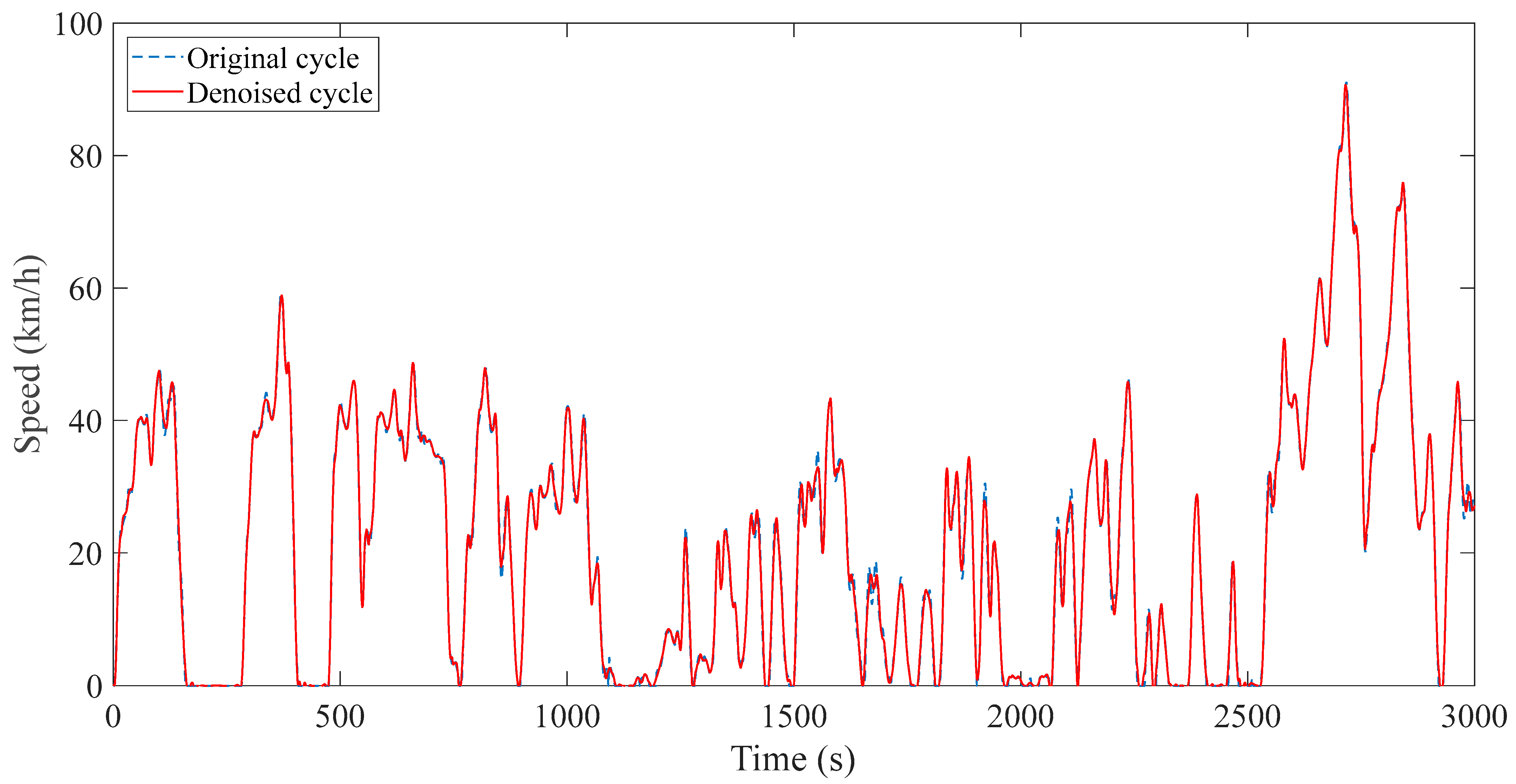
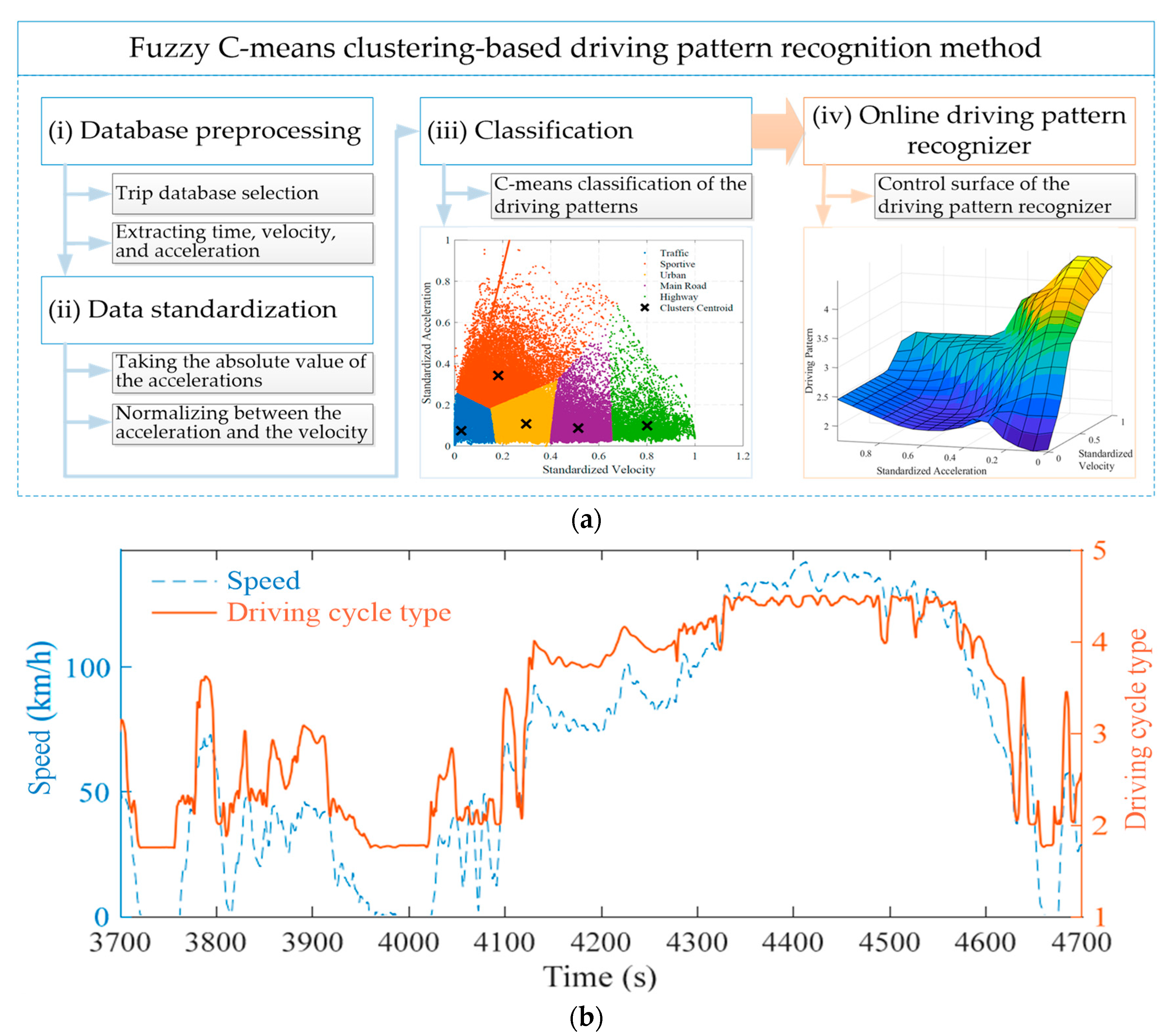

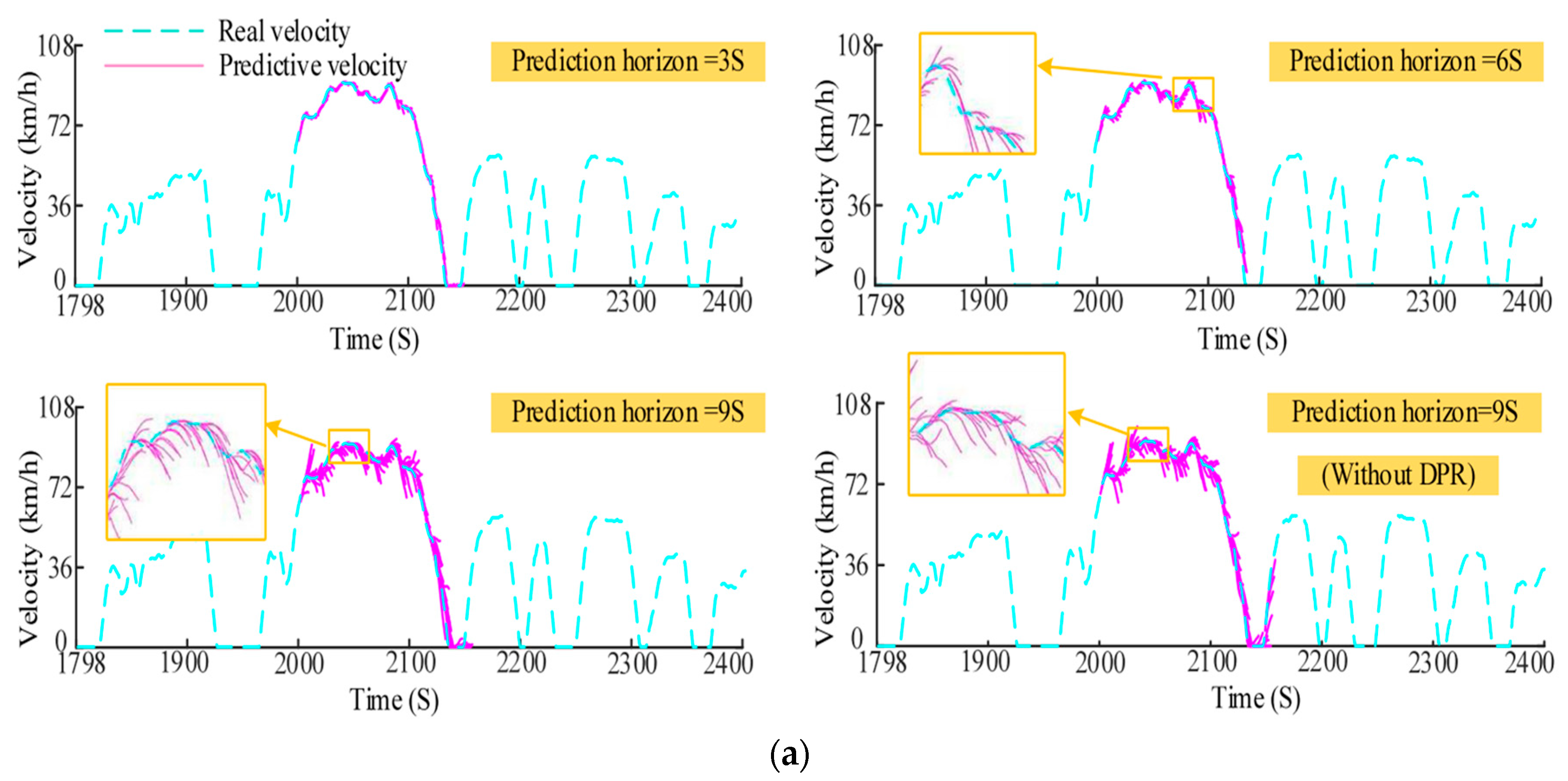
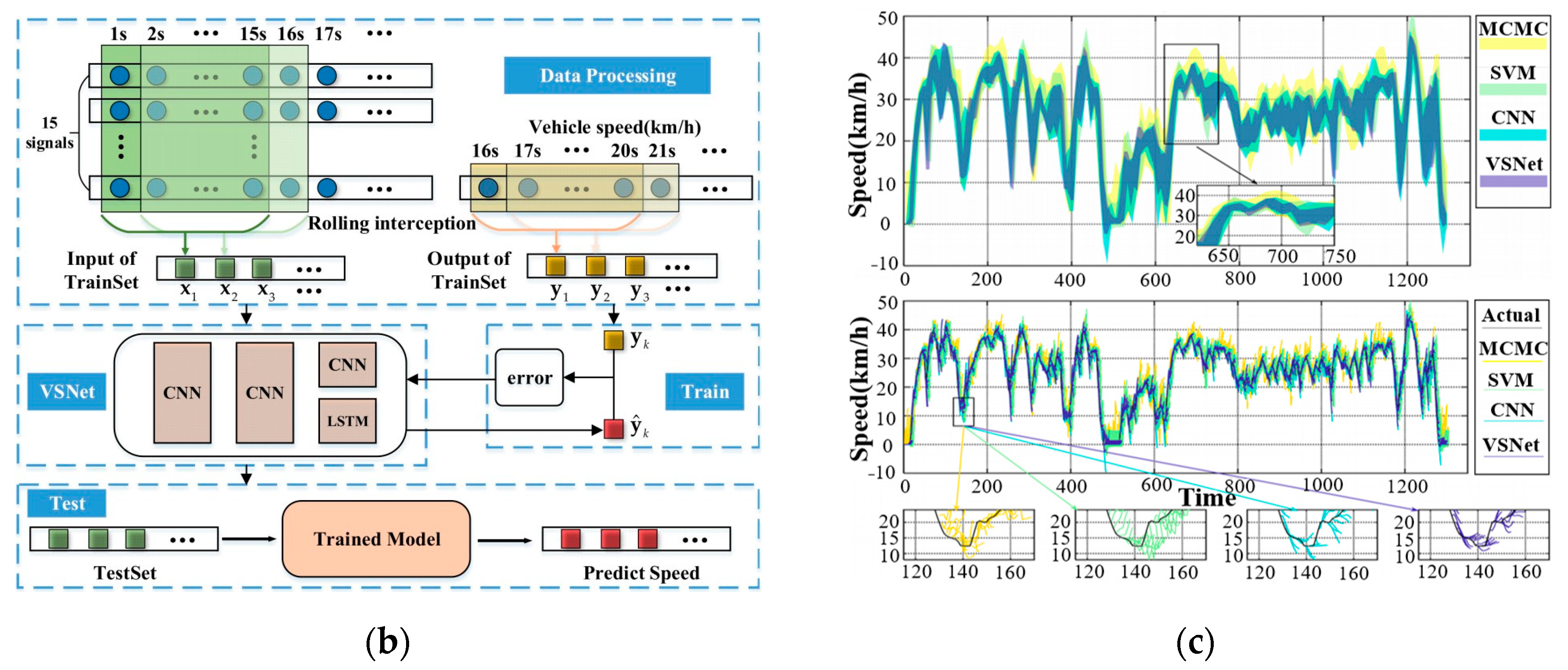
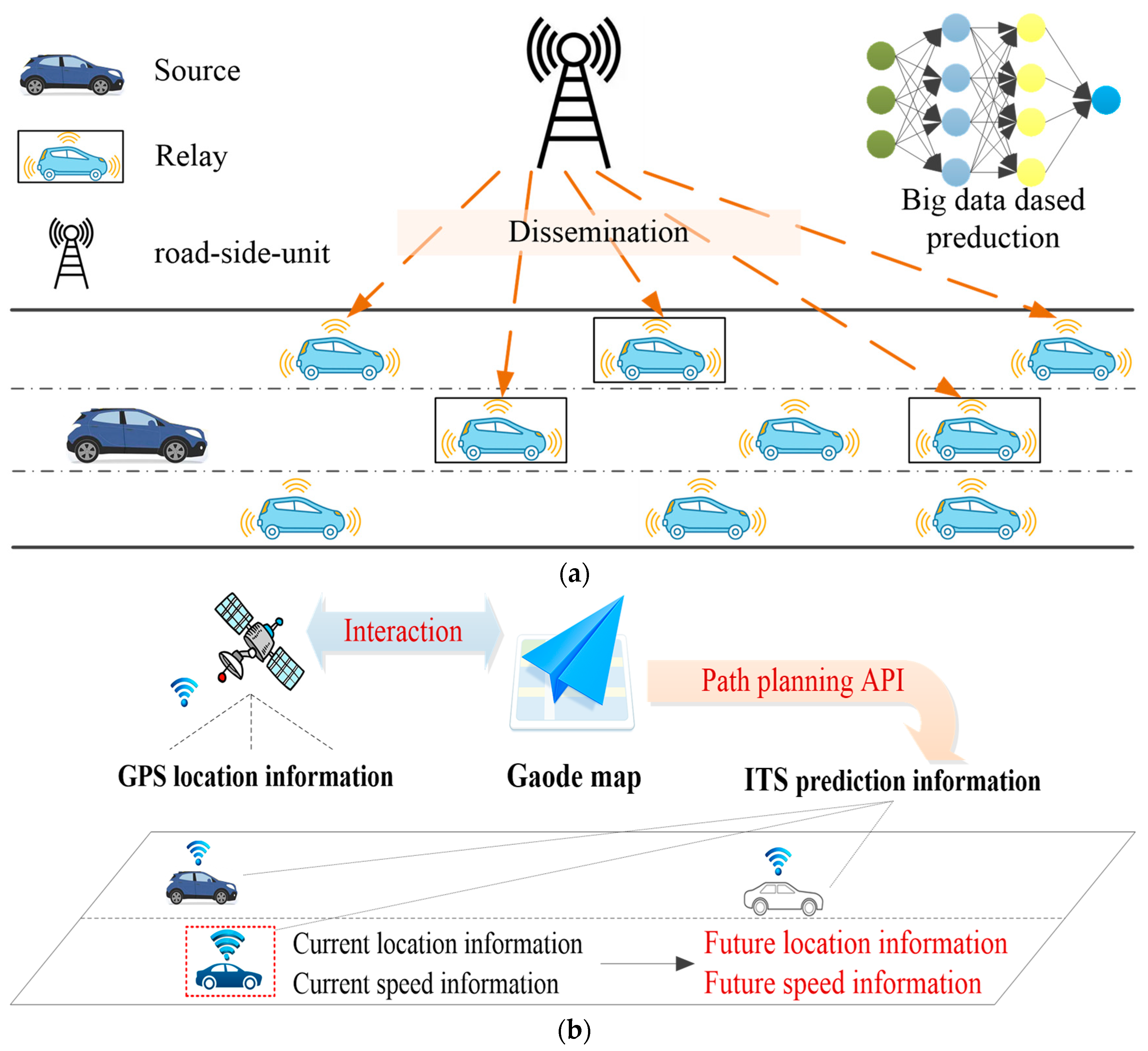
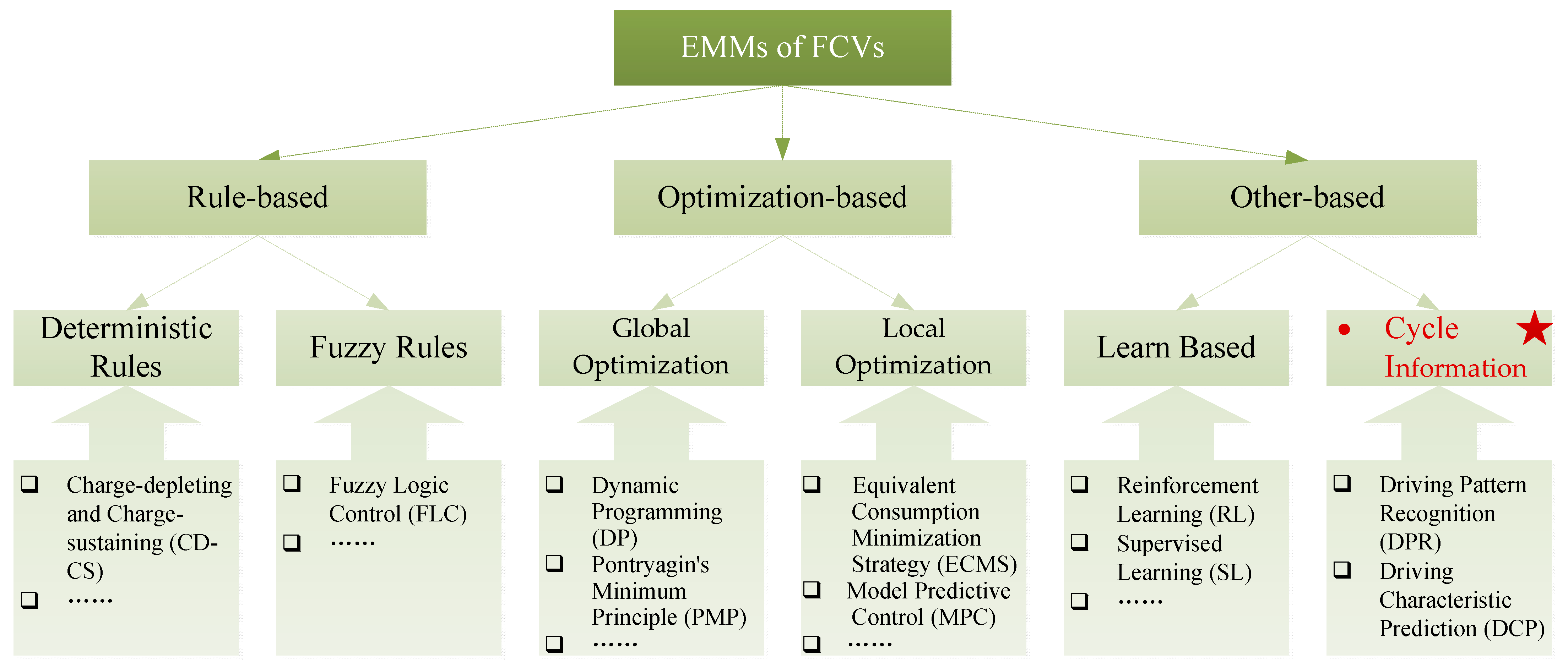
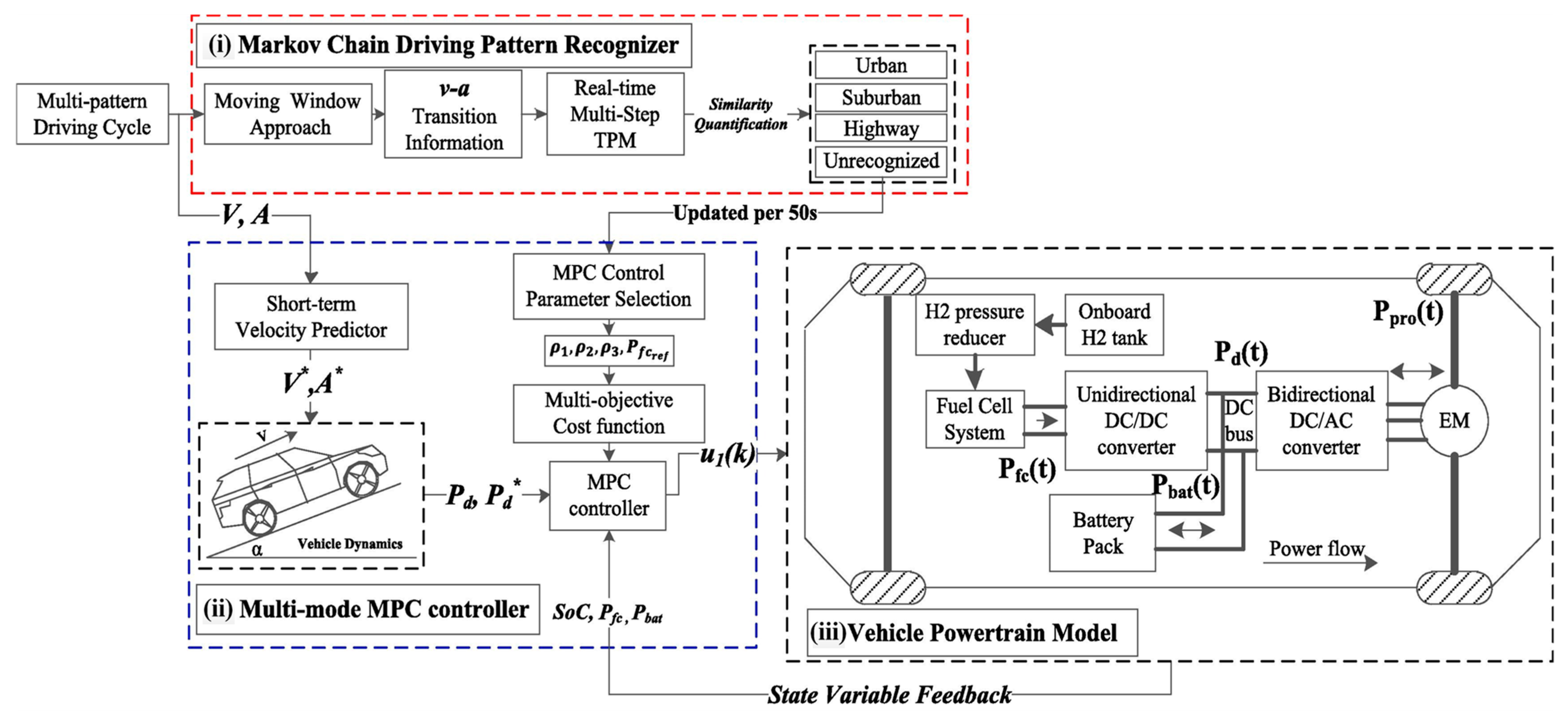
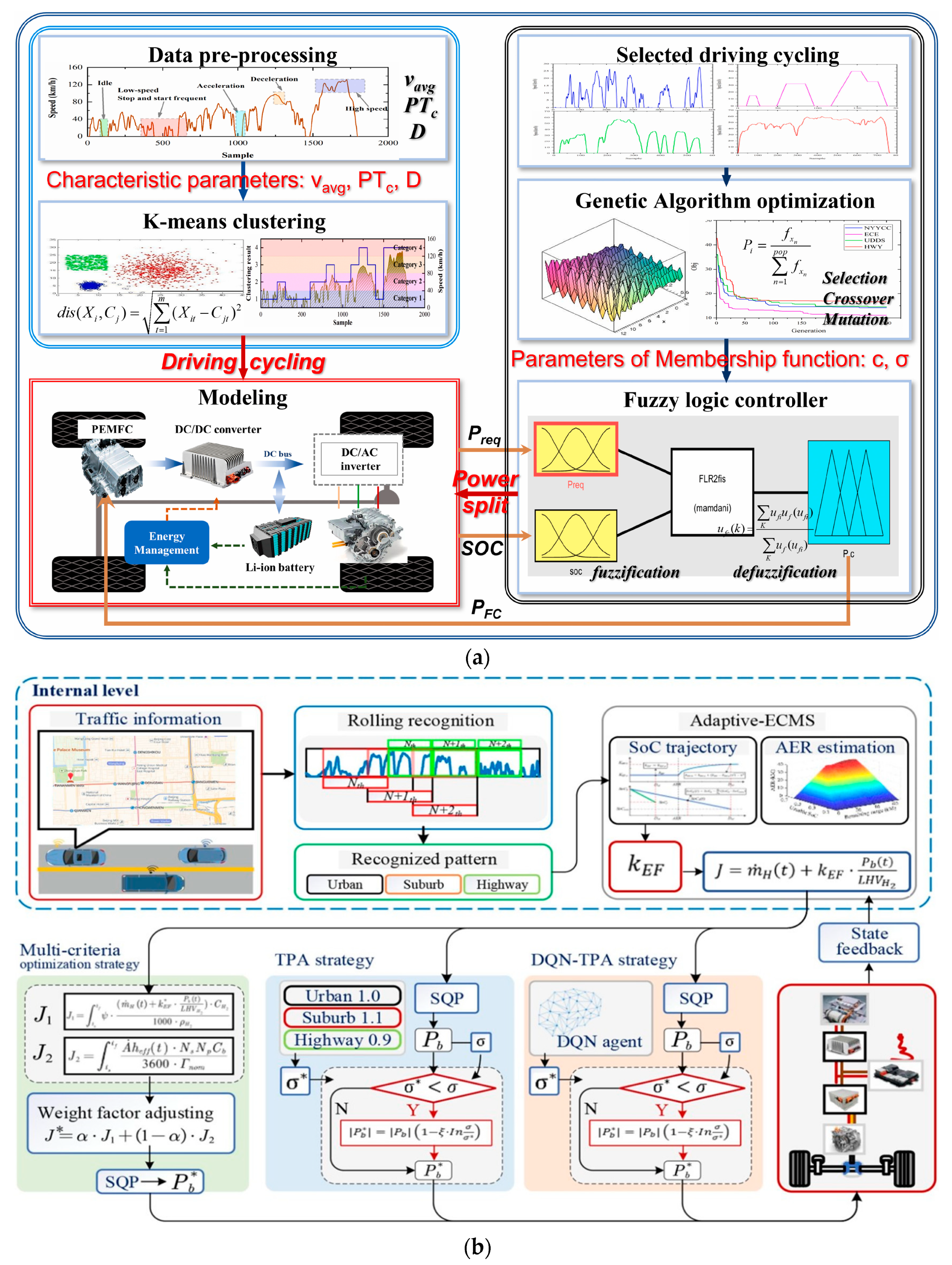

| Scope | Keywords | Results | |
|---|---|---|---|
| Web of Science and Engineering Village (Publisher: MDPI, Elsevier, IEEE, etc.) |
|
| |
| |||
|
| ||
| |||
| Collection Location | Collection Device | Sampling Rate | Main Collected Information | Ref. |
|---|---|---|---|---|
| Chengdu, China | GPS | / | longitude, latitude, time stamp, etc. | [36] |
| Toronto, Canada | Qstarz BT-1000 × GPS | 1 Hz | instantaneous speed, longitude, latitude, and altitude | [37] |
| Michigan, USA | OBD | / | latitude, longitude, vehicle speed, etc. | [38] |
| Islamabad, Pakistan | GPS + OBD | 1 Hz | latitude, longitude, altitude, speed, road slope, etc. | [39] |
| Shanghai, China | Smartphones | 1 Hz | altitude, average speed, average altitude, duration, etc. | [40] |
| Zhengzhou, China | OXTS inertial+ | 5 Hz | velocity, transient acceleration, and road slope | [41] |
| Hsinchu, China | ITS (V2V, GPS, camera, and sensors) | / | latitude, longitude, vehicle current speed, etc. | [42] |
| Algorithm | Advantage | Disadvantage | Ref. | |
|---|---|---|---|---|
| dimensionality reduction | principal component analysis (PCA) | simple and easy to implement, mainstream algorithm | can only extract linear characteristics, inaccurate results | [51] |
| kernel principal component analysis (KPCA) | improvement of PCA, can extract non-linear characteristics | more complex and difficult to implement | [50] | |
| linear discriminant analysis with the diagonal eigenvalues (LDA-DE) | can efficiently handle high-dimensional data, and reduce the computation time | more complex and difficult to implement | [52] | |
| clustering | K-means | simple and easy to implement, mainstream algorithm | slow convergence speed (non-convex dataset), not suitable for complex structure | [53] |
| spectral | high computational efficiency, good convergence | selection of cluster number | [54] | |
| K- modified particle swarm optimization (K-MPSO) | stronger searching ability, more accurate clustering results | more complex with larger calculations | [55] |
| EMMs | DPR Methods | Energy Sources | Simulation/ Hardware | Description | Ref. |
|---|---|---|---|---|---|
| intelligent fuzzy controller | traffic condition recognition algorithm (TCRA) | fuel cells + batteries | Advisor (UDDS/EUDC) | 9~17% fuel consumption improvement vs. primary controller, and 84% correct recognition (TCRA) | [115] |
| adaptive fuzzy controller | neural network (NN) | fuel cells + supercapacitors | Matlab (hybrid cycles) | minimum current fluctuations and fuel consumption vs. conventional EMM, and 95% test accuracy (NN) | [116] |
| multi-mode EMM | LVQ neural network (NN) | fuel cells + batteries | Matlab (multi-cycle)/dynamometer testing bench | economy performance: 8.44% higher than thermostat control strategy with empirical value, 3.71% higher than thermostat control strategy optimized by the genetic algorithm (GA) | [117] |
| adaptive game theory controller | neural network (NN) | fuel cells + batteries + supercapacitors | Matlab (hybrid cycles) | 7.4% reduction in hydrogen consumption and 23.99% reduction in battery degradation cost vs. conventional game theory controller | [118] |
| MPC-based multi-mode EMM | Markov Chain (MC) | fuel cells + batteries | Advisor (three multi-pattern testing cycles) | 2.07~3.26% hydrogen consumption saving vs. single-mode benchmark strategy, and 94.97~98.16% identification accuracy (MC) | [119] |
| adaptive rule controller with optimization | vehicle operation state recognition | fuel cells + batteries + ultracapacitors | Matlab (WLTP) | 33.7% increase in hydrogen consumption, 31.6% decrease in electric power consumption, and 10.94% reduction in the comprehensive operating cost vs. EMM before optimization | [120] |
| EMMs | DCP Methods | Energy Sources | Simulation/ Hardware | Description | Ref. |
|---|---|---|---|---|---|
| hierarchical reinforcement learning EMM |
| fuel cells + batteries (plug-in) | Matlab (UDDS) | 6.46% and 5.82% reduction in hydrogen consumption vs. CD and CS mode, respectively, and 10%~33% reduction in the fuel cell start–stop times vs. rule-based | [127] |
| multi-objective hierarchical prediction EMM |
| fuel cells + batteries (range extended) | Matlab (three testing cycles) | 8.6% and 13.5% reduction in the operating costs vs. CD-CS strategy and the ECMS, respectively | [128] |
| integrated predictive (A-MPC) EMM |
| fuel cells + batteries (range-extended plug-in) | Matlab (five testing cycles) | 3.79% hydrogen consumption saving and 40.4% FC power spikes limiting vs. lower benchmark strategy, and 0.84% fuel economy deficiency and 9.18% fuel cell power transients deficiency vs. DP | [129] |
| real-time multi-criteria control (MPC) EMM |
| fuel cells + batteries | Matlab (multi-pattern testing cycle) | 12.5% hydrogen consumption saving and 94.9% average FC power transients suppressing vs. CD-CS | [130] |
| sequential quadratic programming (SQP) based real-time optimization EMM |
| fuel cells + batteries | Matlab | 7.50% and 2.48% reduction in the powertrain system degradation and total cost of the energy consumption and powertrain system degradation, respectively, vs. ECMS | [131] |
| A-ECMS |
| fuel cells + batteries (heavy-duty vehicle) | Matlab (four driving cycles) | 3.76~11.40% increase in hydrogen consumption vs. standard ECMS, but feasible for realistic conditions | [132] |
Disclaimer/Publisher’s Note: The statements, opinions and data contained in all publications are solely those of the individual author(s) and contributor(s) and not of MDPI and/or the editor(s). MDPI and/or the editor(s) disclaim responsibility for any injury to people or property resulting from any ideas, methods, instructions or products referred to in the content. |
© 2023 by the authors. Licensee MDPI, Basel, Switzerland. This article is an open access article distributed under the terms and conditions of the Creative Commons Attribution (CC BY) license (https://creativecommons.org/licenses/by/4.0/).
Share and Cite
Wang, W.; Hao, Z.; Qu, F.; Li, W.; Wu, L.; Li, X.; Wang, P.; Ma, Y. Review of Energy Management Methods for Fuel Cell Vehicles: From the Perspective of Driving Cycle Information. Sensors 2023, 23, 8571. https://doi.org/10.3390/s23208571
Wang W, Hao Z, Qu F, Li W, Wu L, Li X, Wang P, Ma Y. Review of Energy Management Methods for Fuel Cell Vehicles: From the Perspective of Driving Cycle Information. Sensors. 2023; 23(20):8571. https://doi.org/10.3390/s23208571
Chicago/Turabian StyleWang, Wei, Zhuo Hao, Fufan Qu, Wenbo Li, Liguang Wu, Xin Li, Pengyu Wang, and Yangyang Ma. 2023. "Review of Energy Management Methods for Fuel Cell Vehicles: From the Perspective of Driving Cycle Information" Sensors 23, no. 20: 8571. https://doi.org/10.3390/s23208571
APA StyleWang, W., Hao, Z., Qu, F., Li, W., Wu, L., Li, X., Wang, P., & Ma, Y. (2023). Review of Energy Management Methods for Fuel Cell Vehicles: From the Perspective of Driving Cycle Information. Sensors, 23(20), 8571. https://doi.org/10.3390/s23208571







